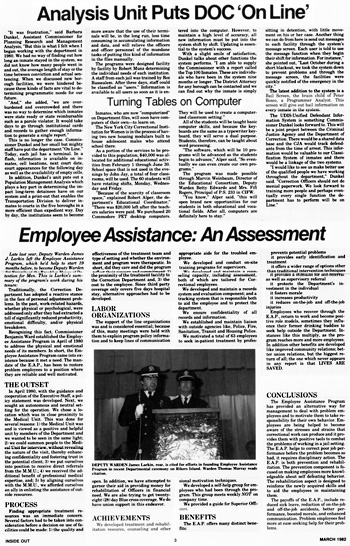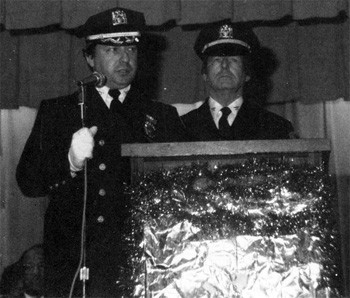 |
Image of Page 3 of the March 1982 issue of NYC DOC's Inside Out tabloid-size newsletter. |
Page 3 of the March 1982 issue of the NYC Department of Correction Inside Out newsletter [See image of Page 3 at right] featured a story on creation of the DOC inmate information system.
Entitled "Analysis Unit Puts DOC 'On Line,'" the article detailed how terminals were installed in each facility, how selected staffers were trained in their use, and how various categories of information were combined into a computer program for monitoring and managing operations involving the inmate population and the individual inmate.
The staff of Inside Out included Errol D. Toulon, then a C.O. who served as its photographer. In due course, he would rise through the ranks to become Correction Academy Deputy Warden during the 1990s.
In the summer of 2010, Toulon, a Monroe College professor, made available to this website a copy of the March 1982 issue of Inside Out.
From that issue copy, the NYCHS webmaster has created this eight-page web presentation of extracted images and texts. This web page's images and texts were extracted from that newsletter issue's Page 3.

“It was frustration,” said Barbara
Dunkel, Assistant Commissioner for
Planning Research and Management
Analysis, “But this is what I felt when I
began working with the department in
1980. We had no way of finding out how
long an inmate stayed in the system , we
did not know how many people went in
and out, the average length of stay or the
time between conviction and actual sentencing. When we discussed new borough facilities, we were hindered because these kinds of facts are vital to determining programmatic needs for our
future.
 |
| DEPUTY WARDEN James Larkin, rear, is cited in recent Departmental ceremony on Rikers Island for efforts in founding Employee Assistance
Program. Warden Thomas Murray reads
citation.
| | Webmaster Note: Click image for larger version. Use browser's "back" option to return to this page. |

Late last year, Deputy Warden James J. Larkin left the Employee Assistance Program, which he'd hel to start 19 months before, to become Deputy Warden for Security at the Brooklyn House of Detention for Men. This is Larkin’s summary of the program’s work during his
tenure:
Traditionally, the Correction Department has adopted a reactive stance
in the face of personal adjustment problems. In the past, work-related hazards,
whether physical or psychological, were
addressed only after they had extracted a
toll of significantly reduced productivity,
emotional difficulty, and/or physical
breakdown.
Recognizing this fact, Commissioner
Benjamin Ward established the Employee Assistance Program in April of 1980
to address the physical and emotional
needs of its members. In short, the Employee Assistance Program came into existence because it met a need. The mandate of the E.A.P., has been to restore
problem employees to a position where
they are reliable and well motivated.
THE OUTSET
In April 1980, with the guidance and
cooperation of the Executive Staff, a policy statement was developed. Next, we
sought an autonomous and neutral setting for the operation. We chose a location which was in close proximity to
the Medical Unit. This was done for
several reasons: 1) the Medical Unit was
and is viewed as a positive and helpful
unit by members of the Department and
we wanted to be seen in the same light;
2) we could summon people to the Medical Unit for interview, without revealing
the nature of the visit, thereby enhancing confidentiality and fostering trust in
the potential client; 3) we put ourselves
into position to receive direct referrals
from the M.M.U.; 4) we received the additional benefit of professional medical
expertise, and; 5) by aligning ourselves
with the M.M.U., we afforded ourselves
an ally in enlisting the assistance of outside resources.
PROCESS
Finding appropriate treatment resources was an immediate concern.
Several factors had to be taken into consideration before a decision on use of facilities could be made: 1) the quality and
effectiveness of the treatment team and
type of setting and whether the environment and program were therapeutic. In
short, did they care and did the program
reflect their concern and commitment; 2)
the proximity of the treatment facility to
the Correction Department and, 3) the
cost to the employee. Since third party
coverage only covers five days hospital
stay, alternative approaches had to be
developed.
LABOR ORGANIZATIONS
The support of the line organizations
was and is considered essential; because
of this, many meetings were held with
them to explain program policy information and to keep lines of communication
open. In addition, we have attempted to
garner their aid in providing money for
rehabilitation of Officers in financial
need. We are also trying to get twenty-
eight (28) day Blue cross coverage. We do
have union support in this endeavor.
ACHIEVEMENTS
We developed treatment and rehabilitation resource, counseling and other
appropriate aids for the troubled employee.
We developed and conduct on-site
training programs for supervisors.
We developed and maintain a counseling capacity, including assessment,
both of which are tailored for Correctional employees.
We developed and maintain a records
system and evaluation component; and a
tracking system that is responsible both
to aid the employee and to protect the
department.
We ensure confidentiality of all
records and information.
We established and maintain liaison
with outside agencies like Police, Fire,
Sanitation, Transit and Housing Police.
We motivated a total of 63 employees
to seek in-patient treatment by professional motivation techniques.
We developed a self-help group for employees who had been through the program. This group meets weekly NOT on
company time.
We provided a guide for Superior Officers.
BENEFITS
The E.A.P. offers many distinct benefits:
it provides early identification and
treatment
it offers a wider range of options other
than traditional intervention techniques
it provides a stimulas br self-referral
as well as supervisory referral
it protects the Department’s investment in the individual
it fosters morale
it increases productivity
it reduces on-the-job and off-the-job
injuries
Employees who recover through the
E.A.P., return to work and become positive role models, sometimes they influence their former drinking buddies to
seek help outside the Department. Instances like this multiply, as the program reaches more and more employees.
In addition other benefits are developed
like improved community relations; better union relations, but the biggest return of all; the one which never appears
in any report is that LIVES ARE
SAVED.
CONCLUSIONS
The Employee Assistance Program
has provided an alternative way for
management to deal with problem em-
ployees and to motivate them to take responsibility for their own behavior. Employees are being helped to become
aware of the stresses and strains that
correctional work can produce and it provides them with positive tools to combat
the problems of working in a jail setting.
The E.A.P. helps to correct poor job performance before the problem becomes so
bad, it requires disciplinary action. The
E.A.P. is both prevention and rehabilitation. The prevention component is focused on making employees more knowledgeable about self defeating behavior.
The rehabilitation aspect is designed to
reinforce the newly acquired skills and
to aid the employees in maintaining
them.
The payoffs of the E.A.P., include reduced sick leave, reduction of on-the-job
and off-the-job accidents, better performance, boosted morale, and enhanced
communication. Problem employees feel
more at ease seeking help for their problems.
|
|
|
“And,” she added, “we are over-
burdened and overcrowded and there
was no way to determine which inmates
were state ready or state reimbursable
such as a parole violator. It would take
days to go through institutional cards
and records to gather enough information to generate a single report.”
This is no longer the case. Commissioner Dunkel and her small but mighty
staff have put the department “On Line.”
Today, each jail has a terminal. In a
flash, information is available on inmates, cell locations, next court date,
court appearances for the following day
as well as the availability of empty cells.
In addition, Dunkel’s unit puts out a
Population Management Analysis which
plays a key part in determining the impact long-term detainees have on our
system and a print-out that enables the
Transportation Division to deliver inmates to courts in the five boroughs in a
more efficient than expedient way. Day
by day, the institutions seem to become
more aware that the use of their terminals will be, in the long run, less time
consuming in accumulating information
and data, and will relieve the officers
and officer personnel of the mundane
tasks of putting this kind of information
in the files manually.
The programs were designed facility
by facility by Robert Munz determining
the individual needs of each institution.
A staff from each jail was trained by Roz
Russealem. After three days, staff could
be classified as “users.” Information is
available to all users as soon as it is entered into the computer. However, to
maintain a high level of accuracy, all
new information must be put into the
system shift by shift. Updating is essential to the system’s success.
With a slight smile of satisfaction,
Dunkel talks about other functions the
system performs. “I am able to supply
the Commissioner with a report called
the Top 100 Inmates. These are individuals who have been in the system nine
months or longer. The District Attorney
for any borough can be contacted and we
can find out why the inmate is simply
sitting in detention, with little movement on his or her case. Another thing
we can do from here is send out messages
to each facility through the system’s
message screen. Each user is told to use
the message function when they begin
their shift for information. For instance,”
she pointed out, “Last October during a
short blackout, we took the system down
to prevent problems and through the
message screen, the facilities were
quickly notified of the emergency in the
city.”
The latest addition to the system is a
Bail Screen, the brain child of Peter
Bosco, a Programmer Analyst. This
screen will give out bail information on
every inmate in the system.
The UDIS-Unified Defendant Information System is something Commissioner Dunkel looks forward to. This will
be a joint project between the Criminal
Justice Agency and the Department of
Correction. There would be a shared data
base and the CJA would track defendants from the time of arrest. This information would be valuable to our Classification System of inmates and there
would be a linkage of the two systems.
“I would like to see us make better use
of the qualified people we have working
throughout the department,” Dunkel
said. “Correction Officers should not do
menial paperwork. We look forward to
training more people and perhaps eventually every single function the department has to perform will be On
Line.”

Inmates, who are now “computerized
on Department files, will soon have computers of their own—to learn on.
The New York City Correctional Institution for Women is in the process of having two new housing modulars built to
house adolescent males who attend
school there.
As a portion of the services to be provided to this population, $40,000 was allocated for additional educational activities from February 1 through June 30
School space that is not used in the evenings by John Jay, a total of four classrooms, will be used. The 60 students will
have rotating shifts, Monday, Wednesday and Friday.
“Because of the scarcity of classroom
space,” explained Robert Alper, the department’s Educational Coordinator, “There was $20,000 left after the teachers salaries were paid. We purchased 20
Commodore PET desktop computers
They will be used to create a computerized classroom setting.”
All of the students will be taught basic
computer skills, and because the key
boards are the same as a typewriter keyboard, they will serve a dual purpose.
Students, therefore, can be taught about
word processing.
“The software, which will be 10 programs will be advanced as the students
begin to advance,” Alper said, “So eventually we can even create our own programs.”
The program was made possible
through Marvin Weinbaum, Director of
the Educational Consortium, Deputy
Warden Betty Edwards and Mrs Fifi
Rogers, Principal of P.S. 233 in CIFW
“You know,” Alper said, “this will
open brand new opportunities for our
students in both educational and vocational fields. After all, computers are
definitely here to stay.”
| |
This is Page 3 of the New York Correction History Society's web presentation of images and texts extracted from NYC DOC's Inside Out issue of March 1982. Links to all 8 pages of the presentation -- each based on its corresponding page in the printed newsletter -- are listed below:
- Page 1 -- Inmate Count Steady, Koch to Grads, Inspection Division Formed.
- Page 2 -- Commissioner Ward's "editorial," Inmate Count story continuation.
- Page 3 -- Start of IIS, of PC lessons for inmates, of E.A.P.
- Page 4 -- DOCers in shooting competition & police olympics, On the Gate personals.
- Page 5 -- Starts: inmate grievance program, KCHPW, centralized & computerized TD.
- Page 6 -- Rose Singer bio, CO recruitment drive, Inspection Div. story continuation.
- Page 7 -- EEO Policy, IG Eng bio, 4 photos of shows at Rikers facilities..
- Page 8 -- Koehler bio, inmates repair parks, HDM COs honor Capt. Giles, IG story jump
Also visit on this site:
|




